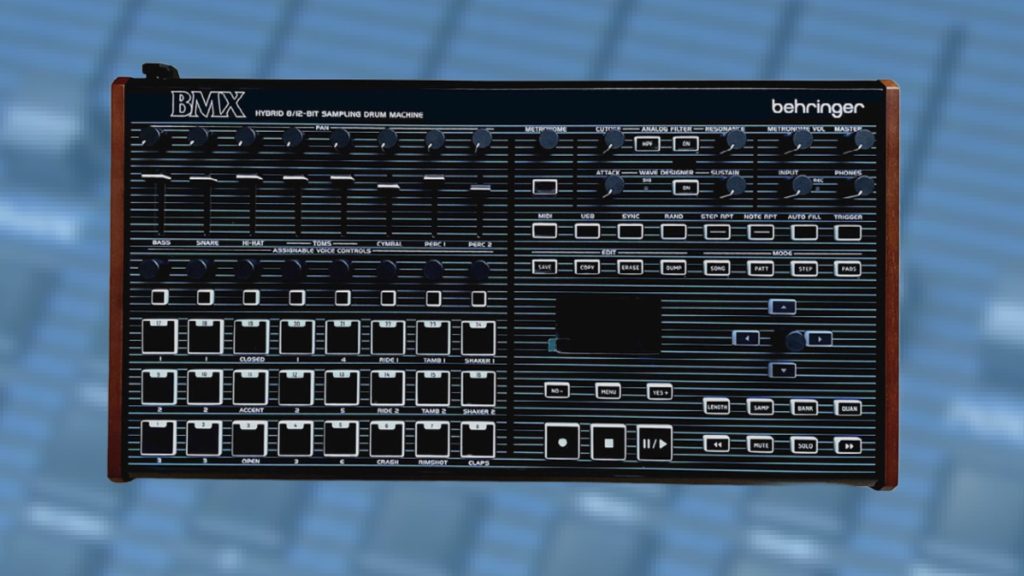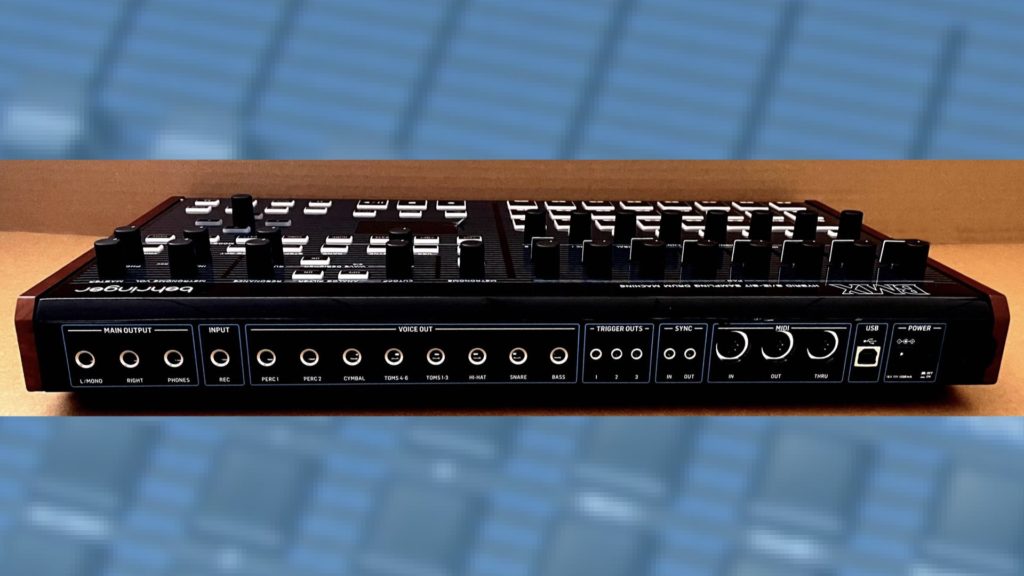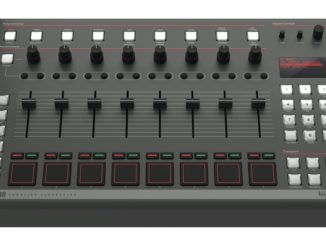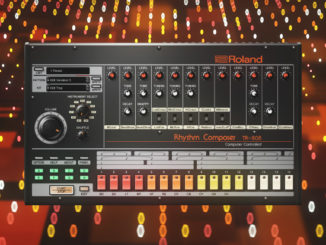Behringer has announced the BMX, a new hybrid sampling drum machine based on the legendary Oberheim DMX from 1980.
And which Behringer replica/clone are you waiting for? Or have you lost track of which ones to watch out for first? Behringer makes your choice even easier. They teased another product today.
Behringer has announced a clone/replica of the legendary Oberheim DMX drum machine from 1980. However, it is more than just a replica.
Behringer BMX
It is immediately noticeable that the BMX is in the same case format as the RD-8 and RD-9. The white and blue stripes looks very similar to the Oberheim original. The BMX is, yes, a clone/replica of the DMX drum machine from 1980. According to Behringer, it will host all the original sound samples.
If they follow the feature set of the original unit, the BMX will have eight parts with in total of 24 drum sounds. But Behringer didn’t leave it at that, which I think is very good.
Its upcoming 8-bit/12-bit drum machine will be hybrid and will have an internal sampling engine in addition to analog filters. Thus, you can also use other sounds with the engine. It will probably also have a creative sequencer, maybe even with parameter automation
Interface side, each track has its own volume slider and pan knob. There are also 24 drum pads, and more. Sound shaping elements such as the controls for the cutoff and resonance of the analog filter are also on the interface.
On the backside, you get a main stereo (L/R) output, headphones, a record in, individual outs, three trigger outs, sync in/out, a full MIDI interface, and a USB port.
Official Behringer FB Release
Friday fun. Our engineers love when they get a new prototype on their desk. Today, we fired up the first version of our BMX prototype, an Hommage to the legendary Oberheim DMX. Aside from the original sound samples, the BMX also has a built-in sampler, analog filters, and much more. This is one cool sampling drum machine. What do you think?
Look for an exciting hybrid drum machine. It’s very welcome that they expanded the concept. The only downer: it will probably take longer until the BMX is available from retailers. At the moment it is still a prototype.
Behringer BMX availability and price TBA.
More information here: Behringer






It looks nice. I dont know whats the differnce with regards to the linndrum clone. They both seem similar. I guess its rather easy to clone the dmx once they have the know how of the linn drum. When will the cloning end. But them having the poly development plattform, it might take some years, but with all the know how they will be able to realize stuff a lot quicker. I hope at one point, all the knowhow will lead to an original offering, which is inspired but takes things in other directions and implements interesting concepts. I am still interested in the Behringer news but they should come up with something like the hydrasynth or the minifreak at one point. there is one thing I dont get. Behringer can make most of their clones look good (maybe a little cheaper than the originals) but their own creations alway look horrible (edge, deepmind, neutron) which is why I am asking myself if they do it on purpose. It would not be more expensive to make them look better.
Edge is not an original design, it’s a clone/replica of the Moog DFAM just in pink and with MIDI 😉
DFAM isn’t really an ‘original design’ either, it’s just 2/3’s of a 960, VCO’s, ladder filter, same EG’s and VCA’s like every other moog product. Moog really hasn’t done anything new since the System 55. it’s all the same circuits inside – just like it sounds. *shrug* it’s fun and I love it, but it could just be patched up on almost any modular.
and still, it remains an original design and new design, even if it’s based on old tech, like every today’s synth. It’s not clone/relica from another company’s product 😉
i imagine they took their core drum machine logic with wave designer and the sequencer used on RD8/9 and added the sampler and ‘play pad’ input method(s) – rather then step entry. added linndrum samples for lmdrum, and DMX samples for BMX. we’ll see. personally, I don’t care about the logic part – it could be anther thing – just the sounds.
in general the first business plan has to succeed before the next is implemented. so wait for the vintage reimagining to generate the profit for the next plan – original synths and instruments.
many companies that go into reverse engineering eventually return to original products with a vengeance. time will tell.
Why buy hardware when software is almost as good?
It’s not like there isn’t a problem with pollution and the climate.
Uli has bet the lot on his Chinese factory, cosying up to a genocidal regime.
Buy something unique that supports a local producer, something built to last, something that supports democracy and not a violent authoritarian regime.
The west is scrambling to get chip production out of Taiwan.
You think we’ve had electronics disruption? Just wait till TSMC and MediaTek are taken over by Beijing.
Get a grip people.
Agreed that we should move away from making China stronger – but software isn’t almost as good in this case, as these are true analog filters with true 8/12 bit processing.
We’d need to hear a head to head. A hardware box is going to be more playable but true digital filters are getting rather good at sounding analog nowadays.
And in the mix? It’s not the authenticity of the clone that going to make for happy listeners.
See Aly James’s take on the Linn Drum for a fine example:
https://soundcloud.com/alyjameslab/vprom-vst-alyjames-feat-legendary-doctor-fink-compressed-version?in=alyjameslab/sets/vlinn-vst-lm-1-drums-emu
Probably all the functions of this future BMX box can be built with Eurorack modules already. Or you buy a used Elektron Analog Rytm on ebay and gain ability to record the individual tracks via a single USB cable (Overbridge) in your DAW.
I have decided to overcome my Behringer Proton desires. I will not sell but skiffcase my DFAM and mount a complex osc module right next to it. More expensive for sure, but also more individual results.
Yeah, Elektron’s dedication to Overbridge is great to see. It was a really tricky problem to overcome.
Most of their stuff is made in Sweden and a little in Poland.
Even the more affordable Model range is made in Sweden.
But don’t get me wrong, I think the Behringer Neutron is the biggest no-brainer in synth history. I can’t sell it, because it has too many valuable functions for me. All that for 300 Euro, it is ridiculous. The red color of its faceplate looks like a warning flag in my rack.
“True 8/12 bit processing” isn’t difficult. Just take a 16-bit word and truncate the 4 LSBs. It would be much more impressive to use a vintage 80s audio path with genuine 8 or 12 bit companding DACs. But this is just an ARM-based sample player with some classic DMX samples loaded.
The irony of typing this on your device….
But the world isn’t black and white, Alessandra.
We try to do better but know we can’t be perfect.
Unfounded quips of hipocrite just make you look ignorant.
You obviously don’t know what device I used.
If it contained 5% China state-backed components or 100% it doesn’t change the message or import of my comment.
A drug addict or a respected doctor can say that meth is bad.
The irony is that in trying to to be smart you broadcast the opposite.
on what device are you typing this?
Announcement after announcement.
Do they actually build anything?
You know very good they build them .
I am waiting for the CS-80 and PolyKobol clones